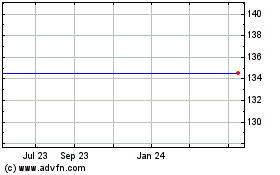Orbital ATK and Intelsat Set to Sign Satellite Servicing Pact
March 08 2016 - 9:40AM
Dow Jones News
Orbital ATK Inc. is moving to create a business out of a concept
science fiction fans have enthused over for decades: launching
robotic space tugs to extend the life of geriatric satellites
circling the Earth.
The Virginia-based aerospace company is close to signing a
pioneering contract with Intelsat SA to use such an automated
spacecraft to grapple and move large telecommunication satellites
that have depleted fuel reserves, keeping them flying while also
bringing in revenue for a few extra years, according to industry
officials.
The tug is designed to use its own propulsion system to maintain
an operational altitude of more than 20,000 miles, then disconnect
and move on to rescue several other ailing satellites during a
projected 15-year mission
Expected to be announced perhaps as early as next month, these
officials said, the deal would cap a lengthy, uphill struggle to
turn in-orbit satellite servicing—once a far-fetched idea
championed by space geeks—into commercial reality. Despite years of
delays, misgivings by investment bankers and ambivalence from most
satellite operators, Orbital ATK has now committed tens of millions
of dollars to build what it calls its first Mission Extension
Vehicle.
Last minute problems could still delay or block a final
agreement, according to industry officials familiar with the
details. But negotiations are far enough advanced for officials of
both companies to consider details of where and when an
announcement will come.
The plan is to conduct a full-blown test of the technology in
space by late 2018 and begin operations a few months later, said
Tom Wilson, vice president of strategy and business development at
Orbital ATK. If successful, the initiative could "change the way we
manufacture satellites, and how we operate satellites," he said in
an interview. "I think the market is ready for it, finally."
With dozens of big telecommunications satellites running low on
fuel each year, Mr. Wilson said the company plans to build and
launch four additional, more-advanced tugs by 2020. In addition to
repositioning satellites, the aim is to eventually fuel or repair
ailing craft with robotic technology.
Such features, among other things, would permit satellites to be
blasted into space with minimum fuel on board—saving substantial
weight and cost—and then they could be refueled during a rendezvous
with a service spacecraft. The ultimate concept is to be able to
swap out modular payloads to upgrade, repurpose or even fix failing
satellites as they zoom through space. "We're working on all that
technology," Mr. Wilson said.
Boeing Co., Lockheed Martin Corp. and Canada's MacDonald
Dettweiler and Associates Ltd. have all expended resources in this
area. A number of U.S. government agencies, including the
Pentagon's primary research arm and the National Aeronautics and
Space Administration, also have provided seed money and encouraged
development.
In-orbit refueling is an essential for deep-space exploration.
The military has long been interested in perfecting technology for
satellites to dock in space, or replace outdated sensors on
spacecraft.
But for now, Orbital ATK appears to have the inside track for
commercial applications. Details of the Intelsat contract are
expected to be wrapped up by the spring, according to industry
officials, and other satellite operators have expressed interest in
the service.
David Thompson, the company's chief executive, recently told
analysts that in-orbit servicing is one of the company's top three
capital investment priorities over the next three years.
Write to Andy Pasztor at andy.pasztor@wsj.com
(END) Dow Jones Newswires
March 08, 2016 09:25 ET (14:25 GMT)
Copyright (c) 2016 Dow Jones & Company, Inc.
Orbital Atk, Inc. (delisted) (NYSE:OA)
Historical Stock Chart
From Jun 2024 to Jul 2024

Orbital Atk, Inc. (delisted) (NYSE:OA)
Historical Stock Chart
From Jul 2023 to Jul 2024
